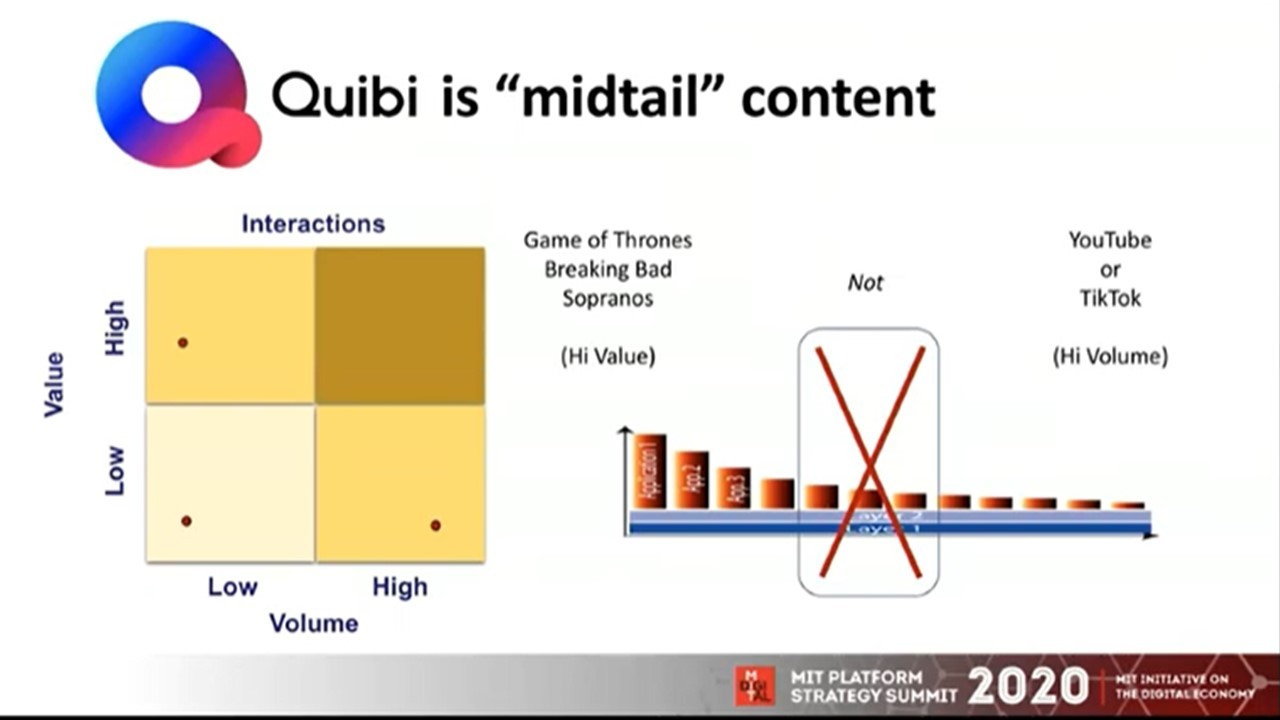One of the conferences I enjoy every year is the MIT IDE Platform Strategy Summit in Cambridge. It is organized by the leading academics in the field of platforms and digital ecosystems, Geoffrey Parker, Marshall Van Alstyne and Peter Evans.[i]
I leave the conference every year with lots of insights and inspiration and also some practical tools about how to build platform businesses.
One of these practical tools presented this year was by Marshall Van Alstyne who briefly mentioned the case of Quibi, the high profile launch by Jeffrey Katzenberg and Meg Whitman, and Quibi has so far failed to live up to expectations of subscriber growth.
Van Alstyne defines a platform as an open architecture with rules of governance designed to facilitate interactions.[ii] He explained that in designing a platform you either want to have high-value interactions, examples are Games of Thrones, Breaking Bad or Sopranos or high volume interactions, examples are YouTube or TikTok.
Quibi is the “watch bite-sized content on your phone” streaming platform that offers entirely new content, dramatic shows, comedic shows, reality TV and news bites intended to be watched while on a subway, between breakfast and your daily exercise, or while riding a Peloton bike, any brief breaks from the activities of the day.

Courtesy of MIT Initiative on the Digital Economy
In the introductory speech of the 2020 MIT Platform Summit – Platform Review and Forecast, about minute 39:50 onwards, Van Alstyne explains how to use this tool for designing interactions.[iii] Quibi, unfortunately, chose a low value, low volume interaction strategy. They are neither “fish nor fowl” as he explains.
I have used this tool in a number of applications over the years. It is really useful when designing a platform and having to make the three key decisions: Interactions, Architecture and Governance.
I found the tool useful not just to designing interactions but also deciding on the type of architecture for the platform. For example, Van Alstyne mentions that TikTok and YouTube have the added advantage that third-parties are creating the content which is the “inverted firm” concept of Van Alstyne and Parker.
How to define value of interactions
In my work on platforms and digital ecosystems, I find it helpful to think of at least three steps: framing, designing, and building the platform or digital ecosystem. Until now I have described the digital tool that Van Alstyne presented in terms of the Designing phase: Interactions, Architecture and Governance.
I also think that the tool helps in the other two phases, namely framing the platform business and in building the platform business. Framing is about what problem you are solving for the customer, the industry or society. From a customer perspective, it is defining what you aspire to stand for, how you connect in their lives, and what meaning you intend to create. In short, it is about the value proposition or brand promise that you deliver or intend to deliver.
Quibi might have missed a beat here. Did it really solve a problem that consumers have by pushing out one episode a day over weeks, when consumers have become used to binge watching entire seasons or watch movies all in one sitting. For more on this, see here.[iv]
The third phase also matters, that of actually building the platform. BCG in a study of 100 platform businesses for example found that seven of ten failed in this phase.[v] That is, a key part of building is scaling the platform in an efficient way. Van Alstyne and Parker discussed this issue as well in numerous articles and books.
I find that it is important that building the platform business requires carefully weighing how to take advantage of network effects, learning effects and viral effects.
Therefore, when I look at the value of interactions, I look at them in three ways: meaning, shared or new value or benefits, and reciprocity. A few examples:
· Meaning
o LEGO’s brand promise is about the joy of building and the pride of creation. When LEGO launched its LEGO Ideas platform where fans of LEGO can submit their own creations and share them with a large network of other LEGO fans, LEGO builds interaction value that reinforces the meaning of the overall brand promise of LEGO.
o Mars Petcare is about creating a better world for pets. Mars launched Kinship which is a business division of Mars and collaboration platform for entrepreneurs, innovators and industry partners to create new products and services to further pet care. The interactions that Kinship creates a meaning for Mars Petcare.[vi]
· New and shared benefits
o When John Deere collects farm data on soil condition and farm productivity data from thousands of farmers, it can use data, analytics and technology to improve productivity per hectare for farmers, but it also can make the data available to Bayer or Dow to optimize crop and fertilizer utilization that creates shared benefits for the industry.
o When Kloeckner, a metal trading firm in Germany introduced XOM, a trading platform, it creates price transparency and also solves for major inefficiencies and frictions in the industry concerning inventory management, hence delivering shared value or benefits for everyone.[vii]
· Reciprocity
o GoPro is best known for its action cameras but its continued success has less to do with camera technology and more with its mobile apps and video-editing capabilities that enables a content platform among millions of passionate GoPro users who create content, upload and share content on the GoPro network. It is the reciprocity of the interactions between users and GoPro that creates enormous value.
o Vitality is an insurance company and program that rewards members for better living, more healthy living. This South African company has figured out that in order to reduce health costs, it isn’t just about cost reductions among providers, payers or pharmaceutical companies, it can also be done by actively involving its members. That is the interactions are designed so that all major participants including patients engage in reciprocal ways to improve health outcomes and reduce overall healthcare costs.
In short, in order to get the maximum impact from network effects, learning effects and viral effects, and to maximize the chances that a platform business is successful, its worthwhile to look at the value of interactions in terms of meaning, benefits, and reciprocity, and frequency or volume, as discussed by Van Alstyne.
For more details, see my new book: https://www.amazon.com/-/es/Erich-Joachimsthaler/dp/1541730518?language=en_US
[i] http://ide.mit.edu/events/2020-mit-platform-strategy-summit
[ii] https://www.weforum.org/whitepapers/platforms-and-ecosystems-enabling-the-digital-economy, page 9
[iii] https://www.youtube.com/watch?v=CUQaqMILuKQ&list=PLNmZUX7tW6t-iapgvuNhHInsUhgu7JyV8&index=2&t=2461s
[iv] https://www.forbes.com/sites/scottmendelson/2020/06/15/why-jeffrey-katzenberg-and-meg-whitman-quibi-was-always-doomed-to-fail/#85d12fb745e9
[v] Ulrich Pidun, Martin Reeves, and Maximilian Schuessler, Why Do Most Business Ecosystems Fail, BCG Henderson Institute whitepaper, https://www.bcg.com/publications/2020/why-do-most-business-ecosystems-fail
[vi] https://www.prnewswire.com/news-releases/first-of-its-kind-coalition-launches-to-drive-pet-care-innovation-300823376.html#:~:text=Kinship%20is%20a%20business%20division,About%20Mars%20Petcare; see also: Thomas W. Malnight, Ivy Buche, and Charles Dhanaraj (2019), “Put Purpose At the Core of Your Strategy,” Harvard Business Review, September – October.
[vii] See for example, Rita Gunther McGrath and Ryan McManus, Discovery-driven Digital Transformation, May-June 2020, Harvard Business Review, https://hbr.org/2020/05/discovery-driven-digital-transformation
